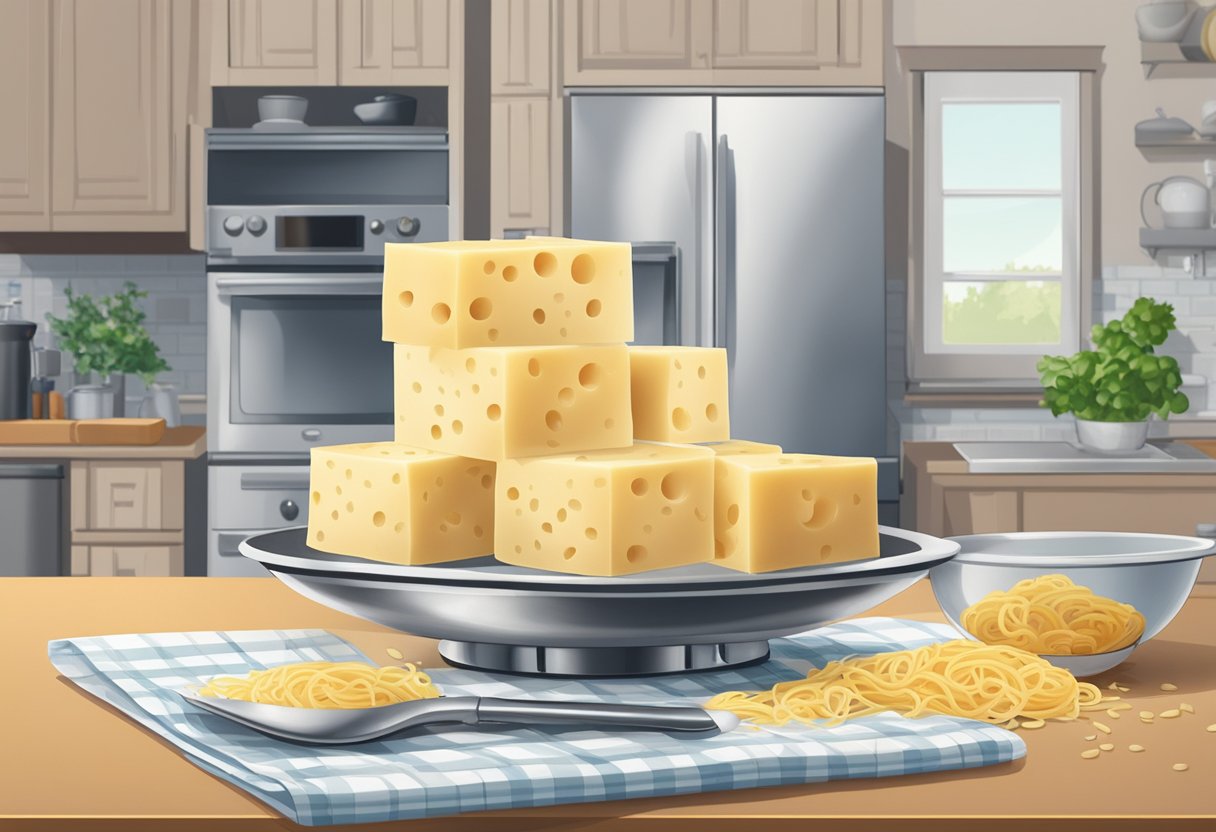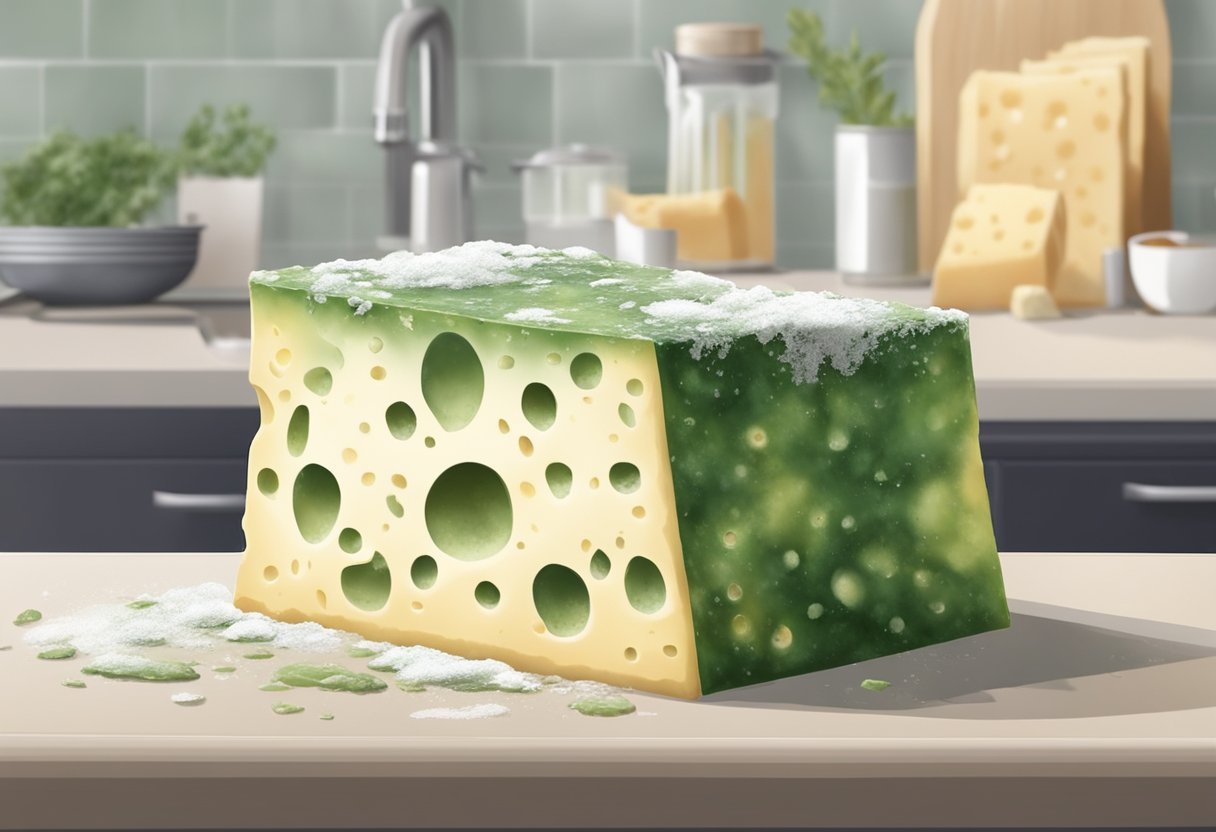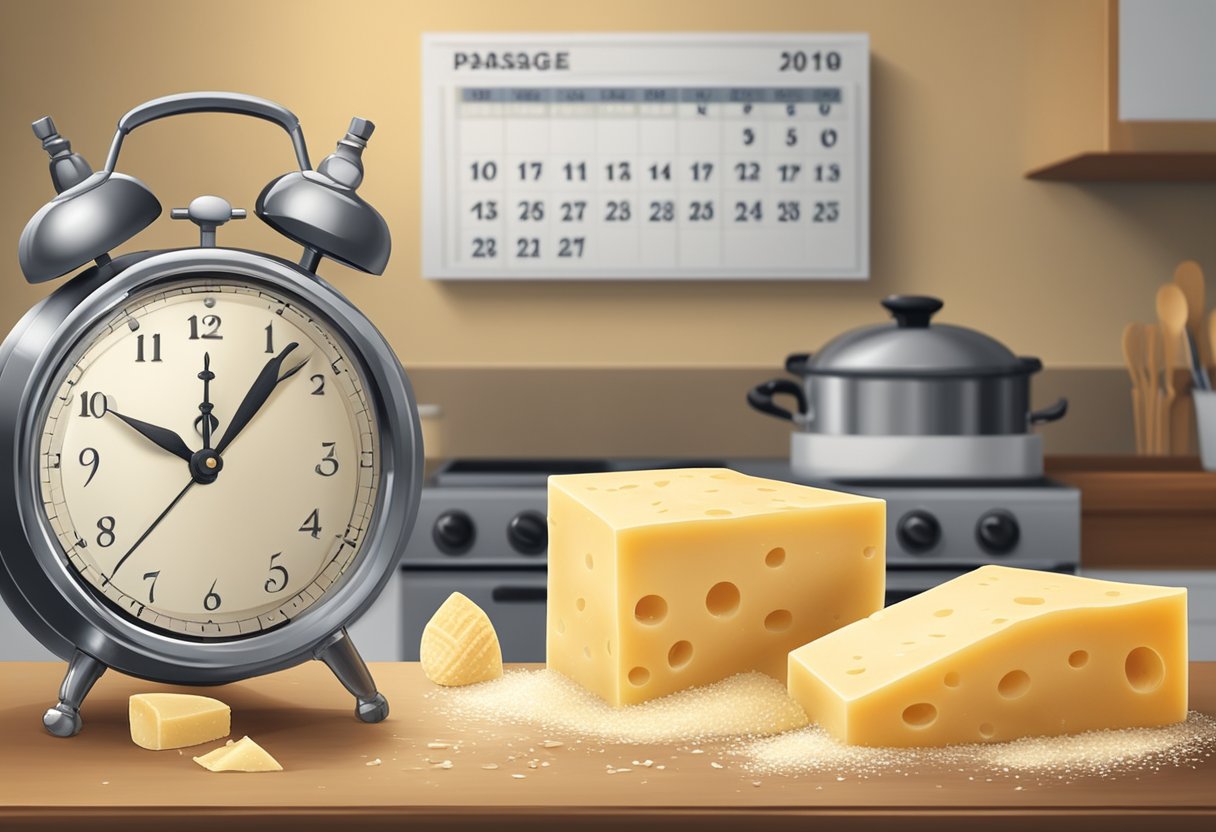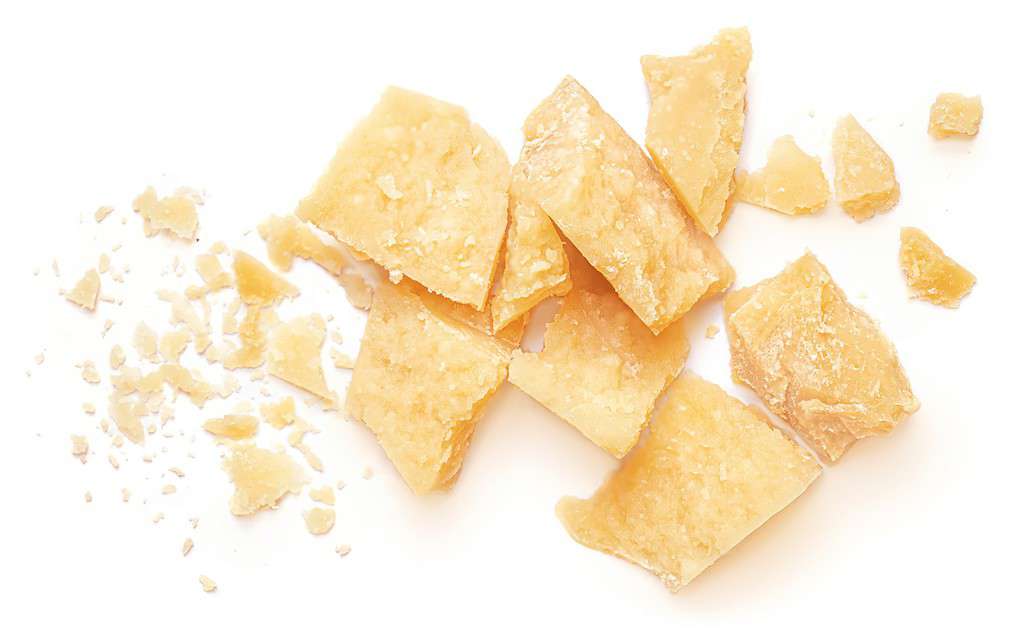Parmesan cheese, known for its hard texture and sharp, nutty flavor, is a staple in many kitchens, especially for those who enjoy Italian cuisine. Its longevity compared to softer cheeses is often noted, which can be attributed to its low moisture content. Understanding how to store Parmesan cheese properly can significantly affect its shelf life, ensuring that its distinctive taste can be savored for as long as possible.

Proper storage is key to maintaining the quality of Parmesan cheese. At room temperature, an unopened package can last for several weeks, but once opened, keeping it refrigerated is crucial. In the fridge, a block of Parmesan cheese can last up to six weeks, while grated Parmesan, with its increased exposure to air, can last about one month if stored correctly. To maximize its lifespan, Parmesan should be kept in an airtight container or wrapped tightly in plastic wrap or foil.
Key Takeaways
- Parmesan cheese’s shelf life can extend to several weeks at room temperature unopened, and up to six weeks in the fridge for a block and one month for grated cheese.
- Correct storage involves refrigeration and airtight containers or tight wrapping in plastic wrap or foil once opened.
- Recognizing spoiled Parmesan is vital to avoid food waste and ensure quality in cooking.
Parmesan Cheese Basics
Parmesan cheese, a hard Italian cheese with a distinctive flavor and texture, is revered for its culinary versatility. Understanding the varieties available and identifying quality will enhance your dining experience.
Different Types of Parmesan Cheese
Parmigiano Reggiano, often regarded as the true Parmesan cheese, hails from Italy, possessing protected designation of origin (PDO) status. It is produced in a specific geographical area, following stringent standards to ensure authenticity. You can purchase Parmigiano Reggiano in various forms:
- Whole wheel: A traditional form, often found in high-end stores or specialty markets.
- Block: A practical and more common option for everyday use.
- Wedge: Typically cut from the wheel, wedges offer a convenient size for household consumption.
Outside of Italy, the label “Parmesan cheese” may cover a broader range of hard cheeses. While these may emulate the flavor and appearance of Parmigiano Reggiano, their production methods can differ significantly.
Identifying Quality Parmesan
When selecting a high-quality piece of Parmesan, consider these sensory attributes:
- Flavor: The flavor should be nutty, rich, and sometimes described as fruity.
- Texture: Look for a granular, crumbly texture in the cheese.
- Aroma: A strong, distinct smell indicative of a good aging process.
- Color: A pale, eggshell-like yellow is characteristic of authentic Parmigiano Reggiano.
Freshness is also a key indicator of quality. Fresh parmesan cheese will have a more pronounced flavor and a texture that is more easily grated. For the best quality Parmesan, ensure that it is improperly stored – ideally in a cool, dry place. When purchased, the cheese should be properly sealed, bearing the marks of authentication if it is true Parmigiano Reggiano.
Storage Fundamentals

To preserve the integrity and extend the shelf life of Parmesan cheese, proper storage techniques are crucial. We must consider the environment, packaging, and methods for both refrigeration and freezing to prevent spoilage and maintain quality.
Refrigeration Guidelines
Storing Parmesan cheese in the fridge requires attention to temperature, humidity, and packaging. Ideally, keep the fridge temperature between 34°F to 40°F (1°C to 4°C) to slow bacteria growth and maintain the cheese’s flavor and texture.
- Packaging for Refrigeration
- Block of Parmesan: Wrap in cheese paper, parchment paper, or wax paper, then place in an airtight container or wrap with plastic wrap.
- Grated Parmesan: Store in an airtight container or a tightly sealed package.
Ensure regular checks for any signs of mold or spoilage, such as discoloration, mold spots, or an off odor.
Freezing Techniques
Freezing Parmesan cheese can extend its shelf life beyond the refrigerator’s capability, albeit with potential quality trade-offs.
- How to Freeze
- Wrap block Parmesan tightly in aluminum foil or freezer wrap, then place into a freezer bag with the air pressed out.
- For grated cheese, use an airtight container or a freezer bag with the air removed.
Label all frozen cheese with the freeze date. Keep in mind that frozen Parmesan is best used for cooking, as freezing may alter its texture.
Preventing Moisture and Mold
Minimizing moisture and preventing mold are paramount to preserve Parmesan’s quality and safety.
- Storage Environment
- Keep the cheese dry and well-ventilated in the fridge or freezer.
- For fridge storage, avoid placing cheese in the moistest areas, like the vegetable drawer.
Be vigilant for any changes in texture, appearance, or smell, which may indicate moisture infiltration or mold growth. If mold is present, discard the affected portion immediately to avoid bacterial contamination.
Shelf Life of Parmesan
We understand the importance of proper storage for preserving the quality and extending the shelf life of Parmesan cheese. Here, we provide detailed information on how long Parmesan cheese lasts in its various forms.
Unopened Blocks and Wheels
Unopened blocks or wheels of Parmesan cheese can typically be stored in the fridge for 7 to 9 months past the printed best-by date. The longevity is due to the low moisture content and hard texture of the cheese, which discourages bacterial growth. For optimal preservation, the cheese should be kept in its original packaging in the crisper drawer of the refrigerator to maintain a consistent temperature and humidity.
- Fridge: 7 to 9 months past best-by date
- Location: Crisper drawer
After Opening
Once the Parmesan cheese is opened, its shelf life decreases. To maximize its freshness, store the cheese in an airtight container or wrap it tightly in cling film or aluminum foil. Properly stored, an opened package of Parmesan can last in the fridge for about 4 to 6 weeks. If the cheese develops mold or a rancid smell, it should be discarded.
- Fridge (opened package): 4 to 6 weeks
- Storage: Airtight container or tightly wrapped
Grated Parmesan Cheese
Grated Parmesan, whether store-bought or homemade, comes with a shorter shelf life due to its increased surface area and exposure to air. Store-bought grated Parmesan in an unopened package can last 7 to 10 days past the expiration date in the fridge. Once opened, it’s best to use within 5 to 7 days. Homemade grated Parmesan should be used within 3 to 4 days. Always store grated Parmesan in the refrigerator in an airtight container.
- Store-Bought (unopened package): 7 to 10 days past expiration date in fridge
- Store-Bought (opened package): 5 to 7 days in fridge
- Homemade Grated Parmesan: 3 to 4 days in fridge
- Storage: Airtight container in refrigerator
Using Parmesan in Cooking

In our kitchen, we consider Parmesan cheese a versatile ingredient that enhances the flavor and texture of many dishes. From freshly grated fine shavings to incorporating chunks of it in recipes, Parmesan is a staple for adding a rich, umami flavor.
Enhancing Recipes with Parmesan
Parmesan cheese, with its robust, nutty flavor and granular texture, is essential for elevating simple recipes. A block of Parmesan can be grated or shaved into fine pieces that blend seamlessly into pasta dishes or become a flavorful garnish for salads and soups. When adding Parmesan to hot dishes like casseroles, baked dishes, or pasta, it’s best to integrate it toward the end of the cooking process to preserve its flavor and prevent it from becoming tough.
- Pasta: Toss grated Parmesan with hot pasta for a creamy texture.
- Salads: Shave Parmesan over greens for a burst of flavor.
- Soups: Sprinkle grated cheese on top for a finishing touch.
- Baked dishes: Layer shaved or grated Parmesan for a crispy, golden crust.
Tips for Cooking with Frozen or Refrigerated Parmesan
Whether you have grated Parmesan frozen for convenience or a block of Parmesan kept cold, both can be used in cooking with slight adjustments. Freezing Parmesan preserves its flavor and is best for pre-grated cheese. If using frozen Parmesan, there’s no need to thaw; it can go directly into the dish. When baking, consider that chilled Parmesan may alter the texture slightly, so it may not melt as uniformly as fresh cheese.
For frozen grated cheese, use it in:
- Cooked dishes: Stir in without thawing for ease of use.
- Baking: Sprinkle atop dough before baking for added texture.
For a block of Parmesan in the fridge, remember to:
- Shave or grate while it’s still cold for easier handling.
- Let it return to room temperature before adding to cold dishes like salads.
Pairing Parmesan with Other Foods
The robust taste of Parmesan pairs well with a variety of foods, from fruits to starchy pasta. When pairing Parmesan with other ingredients, we pay close attention to balance and complementarity. For instance, the salty and savory notes of Parmesan can contrast delightfully with the sweetness of fruits like pears in an appetizer.
Here are some excellent pairings:
- Pasta: Rich cheese complements both light sauces and hearty meat sauces.
- Pizza: A sprinkle adds a sharp, tangy note.
- Casseroles: Incorporate for depth of flavor.
- Fruits: Pair with pears or apples for a sweet-and-savory appetizer.
Incorporating Parmesan into dishes not only adds complexity to the taste but also provides a pleasing change in texture, whether it’s the smooth melt in a pasta dish or the slight crunch in baked toppings.
Recognizing Spoiled Parmesan

To ensure your parmesan cheese remains a delightful addition to your meals, it’s crucial to identify spoilage signs promptly.
Visual and Tactile Indicators
We first observe the cheese’s appearance and feel. Mold typically appears as green or black spots on the surface. If you spot these, you’re witnessing clear signs of mold. Another indicator is discoloration, with the cheese turning a darker beige than normal, suggesting it’s going bad. In terms of texture, fresh parmesan should be hard and crumbly; a spongy texture indicates that the cheese has gone bad and should not be consumed.
Olfactory Signs of Spoilage
Given its nature, parmesan has a distinct sharp aroma when fresh. When it’s starting to go off, there will be a noticeable change in odor, which may become either sour or rancid, signaling that the cheese is no longer safe to eat. Trusting our sense of smell is essential, as an off aroma is often one of the first detectable signs of bacteria growth and spoilage.
Safety Concerns and When to Discard
We prioritize safety, so when we find mold, significant discoloration, or a persistent off odor, discarding the cheese is the best course of action. Even if only part of the cheese shows signs of mold, cross-contamination means bacteria could have spread throughout. Bacteria growth can produce toxins, so if there’s any doubt about the cheese’s condition, we choose to err on the side of caution and discard the questionable parmesan to stay safe.
Frequently Asked Questions

We often receive inquiries about the shelf life and storage of Parmesan cheese. To assist, we’ve compiled a list of common questions and our expert answers.
What are the proper storage methods for extending the shelf life of Parmesan cheese?
To extend the shelf life of Parmesan cheese, keep it in the refrigerator at a temperature between 34°F and 40°F. Store it in a tight container or wrap it in parchment paper followed by aluminum foil to prevent it from drying out. Vacuum-sealed Parmesan cheese can last longer, maintaining quality and flavor.
Can the consumption of expired grated Parmesan cheese lead to health issues?
Yes, consuming expired grated Parmesan cheese can lead to health issues such as food poisoning. Signs of spoilage include an off smell, mold growth, or a change in color. If these signs are present, the cheese should not be consumed.
How can one identify spoilage in Parmesan cheese?
Spoilage in Parmesan cheese is identified by the presence of mold, sour smell, discoloration, and texture changes. If the cheese has any slimy or tacky feel or if mold that cannot easily be removed is present, the cheese has likely spoiled and should not be consumed.
Does the shelf life of Parmesan differ when stored in the fridge versus at room temperature?
The shelf life of Parmesan is significantly longer when stored in the fridge. At room temperature, it is prone to spoilage and drying out. We recommend refrigeration for preserving the cheese’s quality, where a whole piece of Parmesan can last between 4 to 6 weeks and grated Parmesan up to 1 month.
Are there any special considerations for storing Parmigiano Reggiano after it has been opened?
After opening Parmigiano Reggiano, store it in the refrigerator wrapped tightly in parchment paper and then in foil to prevent the cheese from absorbing other flavors and to maintain its moisture. Avoid plastic wrap directly on the cheese as it can cause condensation and mold growth.
How can you prevent mold from developing on Parmesan cheese?
To prevent mold on Parmesan cheese, store the cheese properly by wrapping it in parchment paper and then aluminum foil before placing it in the refrigerator. Ensure your hands are clean when handling the cheese and avoid direct contact with the surface. If the cheese develops small spots of mold, it may be possible to cut off at least an inch around and below the mold spot and still use the remaining cheese.






